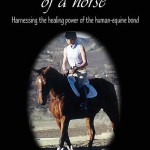
While elaborating on Freud’s notion of denial, Robert Firestone was the first to describe what is now known as fantasy bonding. Fantasy bonding is characterized by the psychological adjustment made by children when enduring physical, psychological or sexual abuse, and involves idealization of the abuser, denial of the abuse, and pseudo-attachment to the abuser. Often, the primitive bond to the abuser is the only hope the child holds for the warmth or nurturance typically promised through human connection.
While the phenomenon of fantasy bonding is now well understood in the therapeutic community, what is much less understood is that of fantasy bonding in horse-human relationships. Under these circumstances, the adult is experiencing the same dynamic of abuse that would be expected in the parent-child relationship where fantasy bonding occurs. That is to say, that the person looks to the horse for comfort, care, nurturance, and warmth, just as a child would a parent. Yet the horse acts in ways that endanger the person. He may, for example, bite, kick, buck, or run off with his human companion. However, like a child who denies his caretaker’s abuse and forms a fantasy bond that allows him to disconnect from the abuse and foster the fantasy of a nurturing caregiver, the person who forms a fantasy bond with the horse also denies both the maltreatment by the horse, as well as, the potential for danger.
While the person’s friends, family, trainers and coaches may express concern for his/her welfare, the person will repeatedly deny the dangerous behavior of the horse and offer alternative explanations, such as, “He was just in pain,” or, “He was scared; that’s why he bit me.” Obviously, the deleterious effects of this sort of denial are evident in the often successive injuries the person may suffer.
So, you may ask, “Why does fantasy bonding between horses and humans occur?” Often, the person in this relationship is merely repeating a former abusive relationship. More often than not, he/she has experienced abuse as a child, and is acting on another facet of abuse, called “repetition compulsion” — the tendency to repeat the abusive pattern. The horse, in this situation, may actually be attempting to engage the person’s latent defense mechanisms — which would interrupt the cycle of abuse and better prepare the person for future threatening situations.
The role of the therapist here is to then make this response of the horse evident to the person (client). In this way the person can begin to unravel the fractured relationship that has developed with the horse, and in doing so, take one step toward overcoming his/her trauma. In future blogs, we will explore the dynamics of trauma in horse-human relationships further.